Not this time. Honda’s CB1000R has already been available in Europe since 2008, and the liter-size sports naked has received positive reviews. For 2011, American Honda reps finally agreed to bring it to the USA.
Conservative as the company is, Honda is producing the CB1000R in limited numbers initially from its Italian manufacturing plant and will increase shipments if sales deem it worthy. As such, don’t expect to see it here in anything except black.
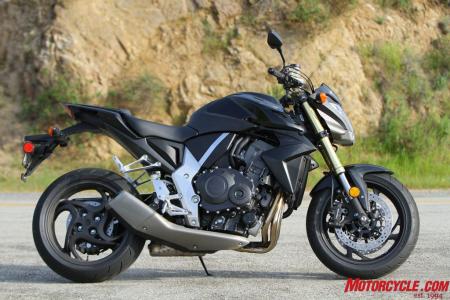 Every once in a blue moon we get a cool bike first seen in Europe on this side of the pond. In this case it’s the 2011 Honda CB1000R. Every once in a blue moon we get a cool bike first seen in Europe on this side of the pond. In this case it’s the 2011 Honda CB1000R. |
Before the age of CBRs, GSX-Rs, ZX-Rs, and YZF-Rs, bikes like the CB1000R were considered the superbikes of the day. With minimal bodywork and upright handlebars, standard bikes like this didn’t have a category – they could do it all. Over the years, that formula has mutated into the genre-specific motorcycles we see today. Honda is aiming to bring back that classic style of the CB750 into a form fit for the 21st century.
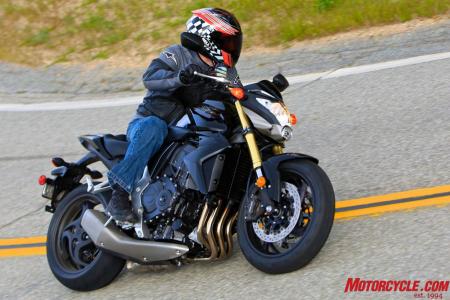 While it doesn’t make nearly as much power as the CBR1000RR it was sourced from, the “retuned” mill provides plenty of grunt for street riding. While it doesn’t make nearly as much power as the CBR1000RR it was sourced from, the “retuned” mill provides plenty of grunt for street riding. |
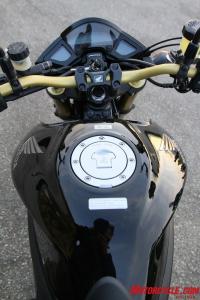 Pictures don’t do it justice, but when viewing the CB1000R in person from this angle, it really is svelte.
Pictures don’t do it justice, but when viewing the CB1000R in person from this angle, it really is svelte.Retuned as it might be, the mill has plenty of power to get you out of the tightest situations. Or, if you’re like me, it has enough grunt to allow the rider to leave it in sixth gear and never touch the shift lever again at speeds above 20 mph. Speaking of gearing, the CB1K shifts with precise clicks each time you call for a gear. This is a feat we’re used to in many of Honda’s sport and sporty-type bikes.
Unlike Honda’s sportbikes, or any sportbike for that matter, the cockpit of the CB1K is noticeably neutral and unusually narrow, especially considering there’s a liter-class engine underneath you. Seat height is a reasonable 32.5 inches. The reach to the gold-anodized, tapered handlebars feels natural, while the footpegs are seemingly directly underneath the seat, which itself is fairly well cushioned. All told, the rider triangle harkens back to that of the CB750 of yore. Its narrow stature, however, “almost feels motard-like” as our own Pete Brissette put it.
A Trip Through Time
Riding the CB1000R is much like being transported back 30 years before motorcycles were so specific. Granted, I wasn’t alive 30 years ago, but I’ve heard stories. It’s so eager to hit the road, and the comfortable riding position makes it enticing to do so. Despite the fact it doesn’t have a windscreen, wind blast is fairly tolerable even at highway speeds.
Around town the bottom-end torque and rather short first gear makes quick work of stoplight drag races. And the fueling, especially at lower speeds, feels refined and seamless. Its narrow profile makes it a great urban dweller, as slicing between cars is supremely easy. The upswept handlebars provide enough leverage to maneuver wherever you need.
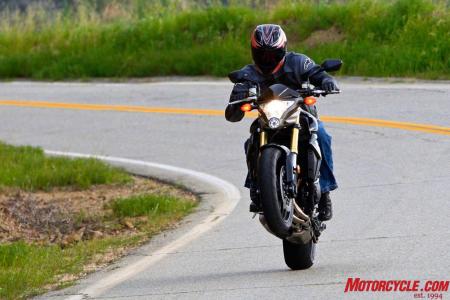 With plenty of torque on hand, simply sit back and twist the wrist and you’ll get results like this. With plenty of torque on hand, simply sit back and twist the wrist and you’ll get results like this. |
That package consists of a fully adjustable 43mm Showa inverted fork in the front and a single Showa shock in the rear, adjustable only for spring preload and rebound damping. That shock is attached to a single-sided swingarm, which adds a bit of class and distinction to an already attractive design.
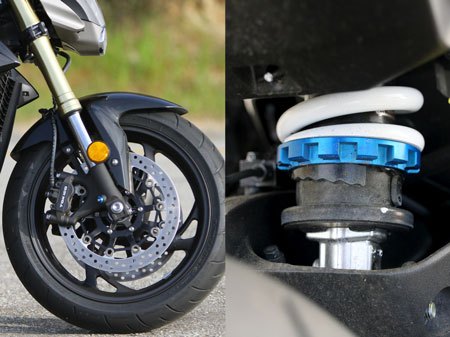 Suspension components are fully adjustable in front and lack only compression damping in the rear. Brakes on the CB are also competent for most situations, though our testers are split on their performance at the limit. Suspension components are fully adjustable in front and lack only compression damping in the rear. Brakes on the CB are also competent for most situations, though our testers are split on their performance at the limit. |
Nonetheless, the CB1000R hides that weight well with its ability to transition side to side extremely quickly and accurately. “Honda engineering at its best,” says Pete. “I don’t know how Big Red hid the extra pounds, but the CB’s feathery handling absolutely makes it feel as lightweight as a modern supersport. I didn’t believe the bike weighed as much as it does until I saw the figure in an official Honda press kit.”
Credit in this department also goes to the 180/55-17 rear tire Honda chose to fit on the CB. The taller, rounder profile helps make turn-in on the nearly 500-pound motorcycle a breeze.
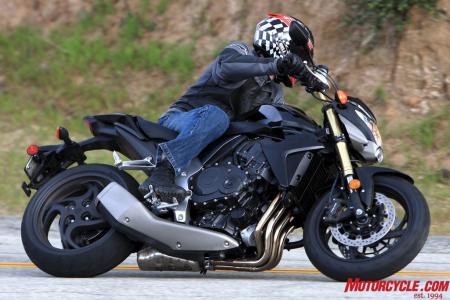 We’re impressed by the Honda’s supremely agile handling, which is at least partly due to the 180/55-17 rear tire. Note also the single-sided swingarm. We’re impressed by the Honda’s supremely agile handling, which is at least partly due to the 180/55-17 rear tire. Note also the single-sided swingarm. |
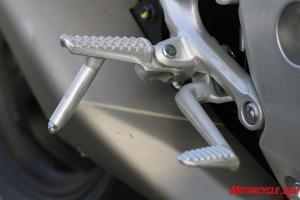 Get a little carried away with lean angle, and these comically long peg feelers will let you know.
Get a little carried away with lean angle, and these comically long peg feelers will let you know.Blast From The Past
All told, the CB1000R really does its best to bring back the spirit and tradition of Hondas of old, but with the usual contemporary upgrades of less weight and more power. Not only does it look the part and carry some design cues from 30 years ago, its overall package feels like a modern-day interpretation of the early CBs as well. On the agility front, it’s uncanny how quickly the bike likes to get on its side.
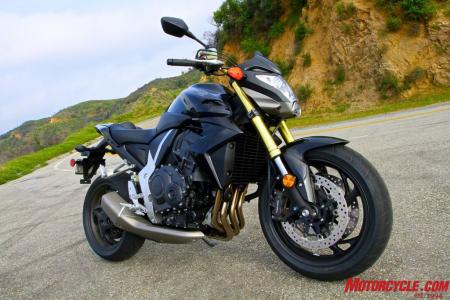 source: http://www.motorcycle.com |
No comments:
Post a Comment